Wadi Rum
Wadi Rum (Arabic: وادي رم Wādī Ramm), known also as the Valley of the Moon (Arabic: وادي القمر Wādī al-Qamar), is a valley cut into the sandstone and granite rock in southern Jordan 60 km (37 mi) to the east of Aqaba; it is the largest wadi in Jordan.[1]
| Wadi Rum | |
|---|---|
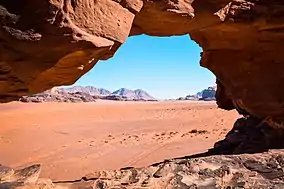 Typical Wadi Rum vista | |
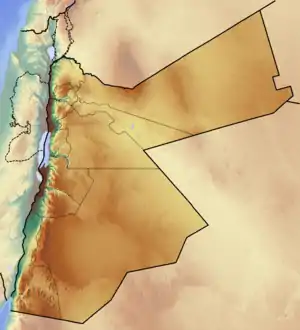 Location in Jordan | |
| Location | Aqaba, Jordan |
| Coordinates | 29°35′35″N 35°25′12″E |
| Area | 720 km2 (280 sq mi) |
| Elevation | 1,750 m (5,740 ft) |
| Named for | Arabic for "Valley of (light, airborne) sand" |
| Operator | Aqaba Special Economic Zone Authority |
| Website | Wadi Rum |
Wadi Rum Protected Area was named a UNESCO World Heritage Site in 2011.
Name
Wadi Rum most likely gets it name from the early name of Iram of the Pillars.[2]
History
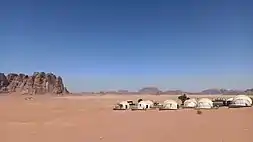
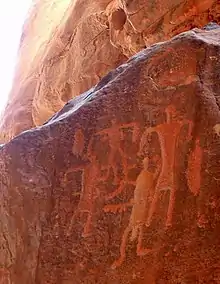
Wadi Rum has been inhabited by many human cultures since prehistoric times, with many cultures–including the Nabataeans–leaving their mark in the form of petroglyphs, inscriptions, and temple. In the West, Wadi Rum may be best known for its connection with British officer T. E. Lawrence, who passed through several times during the Arab Revolt of 1917–18.[3] In the 1980s one of the rock formations in Wadi Rum, originally known as Jabal al-Mazmar (The Mountain of (the) Plague), was named "The Seven Pillars of Wisdom," after Lawrence's book penned in the aftermath of the war, though the 'Seven Pillars' referred to in the book have no connection with Rum.[4]
Lawrence described his entrance into the Valley of Rumm, "The hills on the right grew taller and sharper, a fair counterpart of the other side which straightened itself to one massive rampart of redness. They drew together until only two miles divided them: and then, towering gradually till their parallel parapets must have been a thousand feet above us, ran forward in an avenue for miles. The crags were capped in nests of domes, less hotly red than then body of the hill; rather grey and shallow. They gave the finishing semblance of Byzantine architecture to this irresistible place: this processional way greater than imagination."[5]
Lawrence also described his encounter with the spring, Ain Shalaaleh, "On the rock-bulge above were clear-cut Nabathaean inscriptions, and a sunk panel incised with a monogram or symbol. Around and about were Arab scratches, including tribe-marks, some of which were witnesses of forgotten migrations: but my attention was only for the splashing of water in a crevice under the shadow of the overhanging rock. I looked in to see the spout, a little thinner than my wrist, jetting out firmly from a fissure in the roof, and falling with that clean sound into a shallow, frothing pool, behind the step which served as an entrance. Thick ferns and grasses of the finest green made it a paradise just five feet square."[5]:355
The discovery of the Nabataean Temple (located walking distance from the Rest House) in 1933 briefly returned the spotlight to the desert. A French team of archaeologists completed the excavations in 1997.
Geography
The area is centered on the main valley of Wadi Rum. The highest elevation in Jordan is Jabal Umm ad Dami at 1,840 m (6,040 ft) high (SRTM data states 1854 m), located 30 kilometres south of Wadi Rum village. It was first located by Difallah Ateeg, a Zalabia Bedouin from Rum. On a clear day, it is possible to see the Red Sea and the Saudi border from the top.
Jabal Ram or Jebel Rum (1,734 metres (5,689 ft) above sea level) is the second highest peak in Jordan and the highest peak in the central Rum,[6] rising directly above Rum valley, opposite Jebel um Ishrin, which is possibly one metre lower.
Khaz'ali Canyon in Wadi Rum is the site of petroglyphs etched into the cave walls depicting humans and antelopes dating back to the Thamudic times. The village of Wadi Rum itself consists of several hundred Bedouin inhabitants with their goat-hair tents and concrete houses and also their four-wheel vehicles, one school for boys and one for girls, a few shops, and the headquarters of the Desert Patrol.[7]
Recently, Geoff Lawton has achieved success in establishing a permaculture ecosystem in Wadi Rum.[8]
Tourism
Desert scenes of Wadi Rum in Lawrence of Arabia from 1962 kick-started Jordan's tourism industry.[9]
Wadi Rum is one of Jordan's most popular tourist sites and attracts a number of foreign tourists. Wadi Rum is home to the Zalabieh tribe, who developed eco-adventure tourism and services throughout the protected area. They provide tours, guides, accommodation and facilities. They also run restaurants and small shops in the villages that provide meals and basic supplies for visitors. Their guide services include highly experienced mountain and trekking guides who have an unmatched knowledge of the local area and often speak fluently in one or two languages. Using local guides and services brings many benefits to the protected area. In particular, it enables people to continue earning a living from the land and helps to ensure that the protected area will always be protected.
Popular activities in the desert environment include 4x4 tours, camel rides, camping under the stars, riding Arabian horses, hiking and rock-climbing among the massive rock formations. Travellers staying in the area can overnight in Bedouin Camps located in the desert and glamping hotels. Hikers and adventurous travellers may also opt to camp outdoors under the stars. Tour operators offering this experience provide sleeping equipment, meals and transport.
Dima and Lama Hattab coordinate an annual marathon in the region called Jabal Ishrin.
Rock climbing
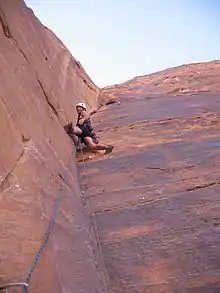
Local Bedouin have climbed in the sandstone mountains of Wadi Rum for many generations. Many of their 'Bedouin Roads' have been rediscovered and documented by modern climbers. Several are included in the climbing guidebook by Tony Howard, and online by Liên and Gilles Rappeneau.[10]
In 1949, Sheikh Hamdan took surveyors to the summit of Jabal Ram. The first recorded European ascent of Jabal Ram took place in November 1952, by Charmian Longstaff and Sylvia Branford, guided by Sheik Hamdan. The first recorded rock climbs started in 1984, with the first of many visits by English climbers Howard, Baker, Taylor and Shaw. This group repeated many of the Bedouin routes, accompanied by locals and independently, including, in 1984, Hammad's Route on Jebel Rum, and, in 1985, Sheikh Kraim’s Hunter’s Slabs and Rijm Assaf on Jebel Rum.[11] Many new routes were climbed in the 1980s, by this team, French guide Wilfried Colonna, by the Swiss Remy brothers, and by Haupolter and Precht.[12] The first dedicated climbing guide book, Treks and Climb in Wadi Rum, by Tony Howard, was first published in 1987. Some of the many Bedouin routes have been documented online by Lien and Gilles Rappeneau.[13] A new routes book for climbers is held at the Wadi Rum Guest House.
The route Guerre Sainte was climbed in 2000 by Batoux, Petit and friends. This was the first route in Wadi Rum to be entirely equipped using bolt protection. The route, on the East Face of Jebel Nassarani North, is 450 m (1,480 ft) long, and graded F7b or F7aA0.[14]
Filming location
The area has been used as a background setting in a number of films. Filmmakers are particularly drawn to it for science fiction films set on Mars.[15]
The Location Managers Guild recognized the Jordanian Royal Film Commission with its LMGI Award for Outstanding Film Commission in 2017 for its work on Rogue One, which filmed at Wadi Rum. The RFC was previously nominated for its work with The Martian.[16]
- Lawrence of Arabia – David Lean filmed much of this 1962 film on location in Wadi Rum.[17]
- Red Planet – Wadi Rum was used as the surface of Mars in this 2000 film.
- Passion in the Desert – The area was also used for scenes in this 1998 film.
- The Face – BBC Film, Rock climbing in Rum, featuring Wadi Rum pioneers Tony Howard and Di Taylor.
- Transformers: Revenge of the Fallen – represented as being in Egypt
- The Frankincense Trail – scenes from train, and aerial filming too
- Prometheus – scenes for the Alien Planet[18]
- Krrish 3 – The Bollywood song Dil Tu Hi Bataa was partly shot on locations in Wadi Rum.
- May in the Summer – a film by Cherien Dabis presented at the 2013 Sundance Film Festival. Long shots of Wadi Rum set the mood for the film, it's a place where the main character finds peace away from the world and within herself.
- The Last Days on Mars – filmed for exterior shots representing the surface of the titular planet for this 2013 film.[19][20]
- The Martian – filming for the Ridley Scott film began in March 2015, for shots that stood in for the surface of Mars.[21] Matt Damon on Wadi Rum:[22]
I was in awe of that place. It was really, really special. One of the most spectacular and beautiful places I have ever seen, and like nothing I’ve ever seen anywhere else on Earth.
- Theeb – Filmed mostly in Wadi Rum, as well as Wadi Araba.[23]
- Rogue One: A Star Wars Story, used for scenes set on Jedha.[24]
- Recording of the album Deserto de Revelação of the Brazilian ministry of praise Diante do Trono in 2017.
- Aladdin, 2019 live action remake of the 1992 Disney animated film of the same name.
- Star Wars: The Rise of Skywalker, used for the desert planet Pasaana.[25]
- Dune (2021), used as a location for the desert planet Arrakis.[26] Timothée Chalamet on Wadi Rum:[27]
That part of the Wadi Rum is so awe-inspiring, you might as well be getting chased by that cliff in the background.
- Aadujeevitham – The desert scenes of the 2020 Malayalam film were mostly shot on locations in Wadi Rum.[28]
Gallery
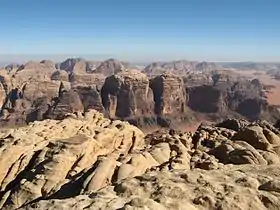 View from the top of Jabal Ram
View from the top of Jabal Ram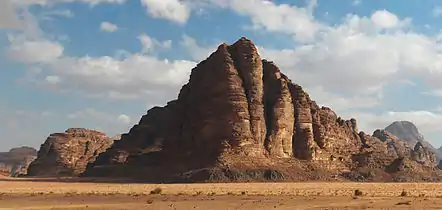 The "Seven Pillars of Wisdom" rock formation
The "Seven Pillars of Wisdom" rock formation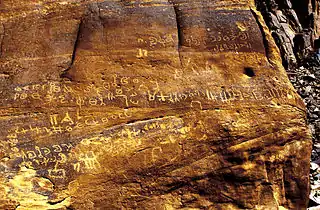 Thamudic inscriptions in Wadi Rum
Thamudic inscriptions in Wadi Rum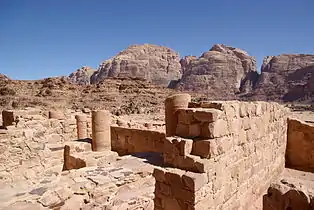 A Nabatean temple in Wadi Rum
A Nabatean temple in Wadi Rum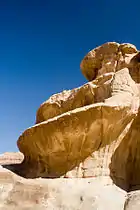 A sandstone formation carved by the elements in Wadi Rum
A sandstone formation carved by the elements in Wadi Rum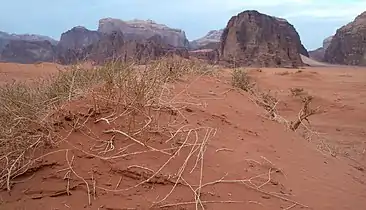 Wadi Rum desert
Wadi Rum desert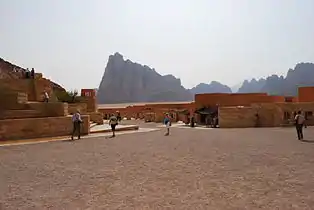 The Wadi Rum Visitor Center
The Wadi Rum Visitor Center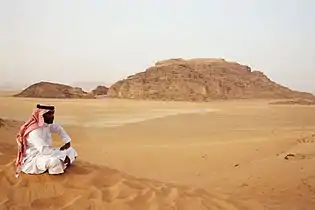 In 2011
In 2011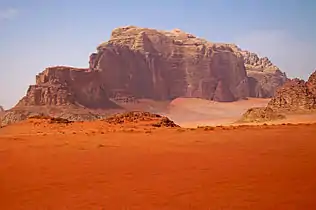 Mountain in Wadi Rum
Mountain in Wadi Rum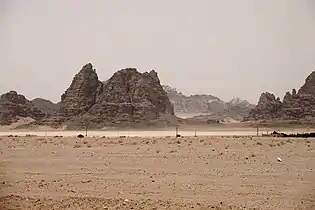 Wadi Rum rock formations along with Bedouin camps
Wadi Rum rock formations along with Bedouin camps Plants in arid Wadi Rum landscape
Plants in arid Wadi Rum landscape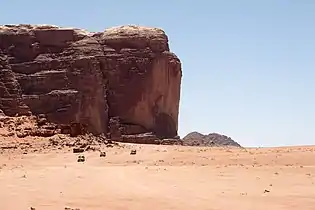 Khazali canyon
Khazali canyon
References
- Mannheim, Ivan (1 December 2000). Jordan Handbook. Footprint Travel Guides. p. 293. ISBN 978-1-900949-69-9. Retrieved 30 May 2012.
- https://www.academia.edu/1184253/_1998_L._THOLBECQ_The_Nabataeo-Roman_Site_of_Wadi_Ramm_Iram_A_New_Appraisal. Missing or empty
|title=(help). - Ham, Anthony; Greenway, Paul (2003). Jordan. Lonely Planet. p. 212. ISBN 978-1-74059-165-2. Retrieved 30 May 2012.
- The Seven Pillars? roughguides.com, accessed 19 June 2018
- Lawrence, T.E. (1935). Seven Pillars of Wisdom. Garden City: Doubleday, Doran & Company, Inc. pp. 351.
- Scheck, Frank Rainer (1997). Jordanien: Völker und Kulturen zwischen Jordan und Rotem Meer (in German). DuMont Reiseverlag. p. 12. ISBN 978-3-7701-3979-8. Retrieved 30 May 2012.
- Howard, Tony; Taylor, Di (May 1997). Treks and Climbs in Wadi Rum, Jordan. Cicerone Press Limited. p. 20. ISBN 978-1-85284-254-3. Retrieved 30 May 2012.
- Craig Mackintosh: FROM DESERT TO OASIS IN 4 YEARS (JORDAN) 1 February 2014 permaculturenews.org, accessed 19 June 2018
- The Complete Guide to Lawrence's Arabia 22 May 2004, independent.co.uk, accessed 19 June 2018
- Gilles, Rappeneau. "Les Voies Bedouin du Wadi Ramm". website. Retrieved 5 February 2014.
- Howard, Tony. "Climbing the Bedouin routes of Wadi Rum". Cicerone Extra. Cicerone Press 2016. Retrieved 26 March 2016.
- Howard, Tony (1987). Treks and Climbs in Wadi Rum. Milnthorpe, England: Cicerone Press. p. 192. ISBN 1 852841354.
- Rappeneau, Gilles. "Les Voies Bedouines des Wadi Ramm". Les Voies Bedouines des Wadi Ramm. Retrieved 26 March 2016.
- "The Guerre Sainte". CamptoCamp.org. Retrieved 17 September 2014.
- Stevens, Dana (1 October 2015). "Saving Astronaut Watney". Slate. Retrieved 2 October 2015.
- "RFC bags 'Outstanding Film Commission' Award". Jordan Times. 10 April 2017.
- "Touristic Sites – South of Amman". Kinghussein.gov.jo. Retrieved 30 May 2012.
- Galloway, Stephen (16 May 2012). "Return of the 'Alien' Mind". The Hollywood Reporter. Retrieved 22 August 2015.
- Forde, Leon (2013-05-28). "Ruairi Robinson, The Last Days On Mars". Screen Daily. Retrieved 2015-02-09.
- Cooper, Sarah (2012-07-19). "Last Days On Mars". Screen Daily. Retrieved 2015-02-09.
- "Ridley Scott's The Martian moves to Jordan". kftv.com. 27 January 2015. Retrieved 19 February 2015.
- "Ridley Scott and Matt Damon on Going to Jordan to Recreate Mars". Yahoo!. Yahoo!. 2015-09-30. Retrieved 2015-10-08.
- Kaleem Aftab: Naji Abu Nowar talks about exploring the Bedouin way of life in his first feature Theeb 25 August 2014, thenational.ae, accessed 19 June 2018
- Jolin, Dan (14 December 2016). "Rogue One: A Star Wars Story — The complete history, Part III". Empire. Retrieved 14 December 2016.
- Arvedon, Joe (22 May 2019). "Star Wars: We Now Know the Name of The Rise of Skywalker's Desert Planet". CBR.com. Retrieved 24 May 2019.
- "Dune: Josh Brolin Reveals Arrakis Shooting Location in New Video". Retrieved 2 May 2019.
- "Dune: Timothée Chalamet On The 'Awe-Inspiring' Desert Shoot – Exclusive Images". Empire. 2020-08-31. Retrieved 2020-08-31.
- https://m.timesofindia.com/entertainment/malayalam/movies/news/prithviraj-sukumaran-and-aadujeevitham-team-to-return-to-kerala/articleshow/75850160.cms
External links
| Wikimedia Commons has media related to Wadi Rum. |
| Wikivoyage has a travel guide for Wadi Rum. |